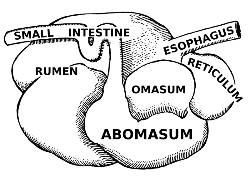The Ruminant Stomach
EUGENE M. MCCARTHY, PHD
The ruminant stomach is a multi-chambered organ found in ruminants (see picture at right). It is usually composed of four separate chambers and allows digestion of large quantities of plant matter that would be relatively indigestible for most other types of mammals, in particular grass and the leaves.
The upper part of this stomach is where fermentation of green foliage takes place with help from anaerobic bacteria. These bacteria allow ruminants to break down cellulose, a major component of all leaves. The slow fermentation and digestive processes that occur within this complex stomach also allow better absorption nutrients as they go on from the stomach to pass through the intestines. Having a ruminant stomach is a big advantage because it makes it so easy to find something to eat (cellulose is the most abundant organic compound on earth).
What are ruminants?
Ruminants are mammals that chew cud, that is, they regurgitate partially digested solids (the cud), and chew them again. They then re-swallow the cud. This re-chewing of the cud to further break down the semi-digested food is called “ruminating.”
Such animals include many members of the order Artiodactyla, such as cattle, goats, sheep, bison, yaks, water buffalo, antelope, deer, and giraffes, but not pigs, which are also artiodactyls. The stomach of a pig is simple like that of a human being, except for the presence of a small pouch or diverticulum at its cardiac end. Camelids (camels, alpacas, and llamas) are artiodactyls and ruminate, but they have three-chambered stomachs.
How a ruminant stomach works
A ruminant begins by chewing and swallowing its food. The ingested matter is then softened within the first two chambers of the stomach, the rumen and reticulum, which communicate freely with each other (considered as a single unit, these two chambers are called the “reticulorumen”). Microbes convert the food, particularly cellulose, into less indigestible substances. The animal regurgitates the cud, and chews it again, and re-swallows it.
The liquid portion of the material within the reticulorumen, passes on to the next chamber, the omasum. Here, water and minerals are absorbed into the blood. The remaining matter moves into the fourth chamber, the abomasum, which is equivalent to the ordinary stomach found in non-ruminants.
Leaf Monkeys
Leaf monkeys, primates of the genera Semnopithecus amd Trachypithecus, also ruminate. Like other ruminants, the slow fermentation that occurs within their chambered stomachs allows them to digest high-cellulose leaves that most other types of mammals cannot, even leaves containing toxins. It also allows them to eat a wider variety of other types of foods than do other monkeys. For example, the Hanuman Langur (Semnopithecus entellus) regularly eats fruits with high strychnine content that would kill most monkeys. So leaf monkeys can not only feed off a wider variety of food items than other monkeys, but also digest those foods more efficiently than do other primates.
Some marsupials ruminate
Kangaroos and certain other Australian marsupials also ruminate. Marsupials are mammals in which the young emerge from the womb at a very early stage of development and attach themselves to the mother's nipples. Many, but not all, marsupials have a pouch in which development of the offspring occurs. The Virginia Opossum (Didelphis virginiana) is a well known example (though it is an American marsupial and does not ruminate).
